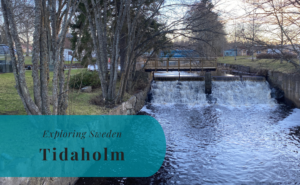Piteå is a small town in the north of Sweden. It is the most visited summer destination in Norrbotten Country and it is the coast around the town that attracts visitors. The town is famous for the Westrobothnian dialect “Pitemål”, which a small part of the around 23.000 inhabitants speaks. There is also the traditional dish, “Pitepalt”, a kind of meat-filled dumpling. Here you will find a historical town, with its own traditions and with the Bay of Bothnian right next door.



A Short History
Piteå was established in 1620 by 44 settlers and it received its town privileges by the king Gustavus Adolphus a year later. That’s the same king who is famous for the rise of the Swedish Empire and his victories during the Thirty Years’ War before he died in Lützen. Its current location was established in 1668 after a great fire had ravished the first location in 1666.
As with many coastal towns in Sweden, the beginning of the 18th century meant that the town was plundered by Cossacks forces and burned by the Russian fleet. During the Finnish War, in 1809, Russian forces invaded Piteå. The last battles of the war took place around Piteå and resulted in Russian victory with six dead on the Swedish side and thirteen on the Russian. The small number of casualties didn’t prevent the Russian forces from plundering the town once again.
Throughout the years, Piteå has had the forest as its most important industry, with several paper mills and sawmills. In more recent years the construction of Markbygden Wind Farm, which should be finished by 2023, is adding a new industry to the area. It is expected to house 700-800 wind power plants, becoming the largest land-based wind farm in Europe.



Things to Do and See
Either if you are looking for a day walking along the streets of a picturesque small town, spending a day at the beach or enjoying outdoor activities, Piteå has a lot to offer. Here is a handful of what is available.
Byxtorget
Byxtorget, or the square of pants, is along with Rådhustorget, one the two main squares in the center of Piteå. They are connected by the pedestrian street Storgatan. The squares are full of shops, cafés, and restaurants.
Pite Havsbad
Pite havsbad is mainly a beach at the estuary of the Pite River at the Bay of Bothnia. From being a sandy beach stretching for kilometers, it has developed into a tourist attraction with camping, hotels, pools, etc.
Piteå Archipelago
The archipelago of Piteå is home to 550 islands, with fishing villages, nature reserves, sandy beaches, and nature at its best. It might be located in the north of Sweden, but the water temperatures in the sea are sometimes among the highest in the country.
Piteå in Winter
Piteå is only about 100 kilometers south of the Arctic Circle. This means that proper winter conditions are not uncommon, with long dark nights and plenty of snow. There are outdoor activities all year around and wintertime means the possibility of skiing and dog sledding. And if you are lucky, you might see the Aurora Borealis.



How to get to Piteå
- Flights: Luleå Airport (LLA) is located 55 kilometers to the north and connects the area with the Stockholm-Arlanda Airport (ARN) for connections around the globe.
- Car: Piteå is located along highway E4 between Skellefteå and Luleå.
- Train: Northbound trains from Stockholm stop in Älvsbyn, from where it is possible to take local buses to Piteå.
- Bus: There are regional buses connecting Piteå with the surrounding area.
The driving distance from 5 major Swedish cities, according to Google Maps:
- Stockholm – 850 kilometers (9 h 2 min)
- Gothenburg – 1199 kilometers (13 h 26 min)
- Malmö – 1458 kilometers (15 h 10 min)
- Linköping – 1045 kilometers (10 h 50 min)
- Kiruna – 390 kilometers (4 h 28 min)
Find out more about other destinations in Sweden by visiting our page Exploring Sweden







That looks really lovely, though I imagine October might not be the best time to visit. I love the wooden buildings, though of course they meant fires were common.
Luckily we visited in July, which meant quite good weather 🙂
As with many places in Sweden, the central area is mostly build in stone. But there is something special with the few surviving wooden buildings. 🙂